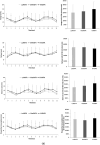Does physical activity level and total energy expenditure relate to food intake, appetite, and body composition in healthy older adults? A cross-sectional study
- PMID: 39853478
- PMCID: PMC11761991
- DOI: 10.1007/s00394-024-03571-z
Does physical activity level and total energy expenditure relate to food intake, appetite, and body composition in healthy older adults? A cross-sectional study
Abstract
Purpose: With ageing, older adults (≥ 65 years) may experience decreased appetite, contributing to declines in body weight and muscle mass, potentially affecting physical capabilities. Physical activity (PA) has been suggested as a potential strategy to enhance appetite in older adults, but evidence supporting this is insufficient. This study aimed to investigate the relationship between PA levels, total energy expenditure (TEE), body composition, energy intake (EI) and appetite in older adults.
Methods: One hundred and eight healthy older adults (age 70 ± 4 years; BMI 24.3 ± 2.6 kg/m2) were categorised into three groups (low, medium, high) based on accelerometer-measured PA level (AMPA) and TEE from 7-day PA diaries. Body composition was measured using bioelectrical impedance. Energy and nutrient intakes were assessed using 3-day weighed food diaries. Appetite was assessed using the visual analogue scales at 30-min intervals throughout 1 day.
Results: TEE was positively correlated with EI and % muscle mass (p < 0.05), with higher % muscle mass and TEE associated with higher EI. Energy and protein intake were significantly higher in the high TEE group than the low group (p = 0.03, p = 0.01; respectively). No significant differences in energy and macronutrient intake were observed across AMPA groups, and appetite components (hunger, fullness, desire to eat, prospective consumption) did not differ significantly in either the AMPA or TEE groups.
Conclusions: Higher TEE is associated with higher energy and protein intake, with body composition playing a crucial role. These findings highlight the importance of considering PA, TEE, and body composition in interventions aimed at improving EI in older adults.
Clinical trail registration: clinicaltrials.gov as NCT05067036. Registered 2 October 2021, https://classic.
Clinicaltrials: gov/ct2/show/NCT05067036.
Keywords: Appetite; Body composition; Energy intake; Older adults; Physical activity; Total energy expenditure.
© 2025. The Author(s).
Conflict of interest statement
Declarations. Ethics approval and consent to participate: This study approved by University of Reading Research Ethics Committee (study number UREC 20/32; Clinical Trials Database Registration ID NCT05067036). All participants provided written informed consent before participation. Conflict of interests: The authors declare that they have no conflict of interests.
Figures



Similar articles
-
CALCULATION OF TOTAL ENERGY EXPENDITURE IN ADULTS WITH CROHN'S DISEASE BY INDIRECT CALORIMETRY AND SIMPLE WEIGHT-BASED EQUATIONS: A COMPARATIVE STUDY.Arq Gastroenterol. 2025 Jun 16;62:e24122. doi: 10.1590/S0004-2803.24612024-122. eCollection 2025. Arq Gastroenterol. 2025. PMID: 40531684 Free PMC article.
-
Assessment of energy requirements in patients with short bowel syndrome by using the doubly labeled water method.Am J Clin Nutr. 2016 Jan;103(1):77-82. doi: 10.3945/ajcn.115.122408. Epub 2015 Dec 16. Am J Clin Nutr. 2016. PMID: 26675764
-
What is the effect of diet and/or exercise interventions on behavioural compensation in non-exercise physical activity and related energy expenditure of free-living adults? A systematic review.Br J Nutr. 2018 Jun;119(12):1327-1345. doi: 10.1017/S000711451800096X. Br J Nutr. 2018. PMID: 29845903
-
Does Habitual Physical Activity Increase the Sensitivity of the Appetite Control System? A Systematic Review.Sports Med. 2016 Dec;46(12):1897-1919. doi: 10.1007/s40279-016-0518-9. Sports Med. 2016. PMID: 27002623 Free PMC article.
-
Development and validation of age-specific predictive equations for total energy expenditure and physical activity levels for older adults.Am J Clin Nutr. 2024 May;119(5):1111-1121. doi: 10.1016/j.ajcnut.2024.02.005. Epub 2024 Mar 19. Am J Clin Nutr. 2024. PMID: 38503654 Free PMC article.
References
Publication types
MeSH terms
Associated data
LinkOut - more resources
Full Text Sources
Medical

